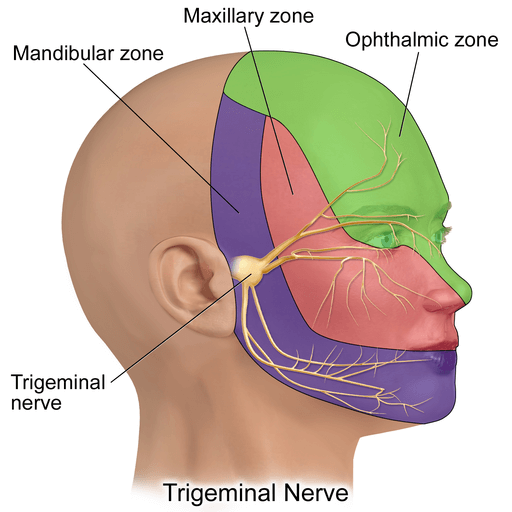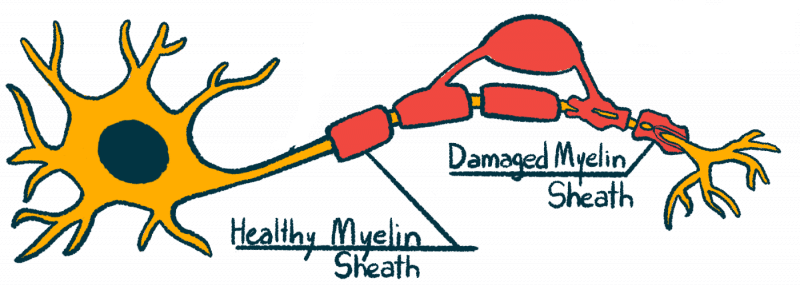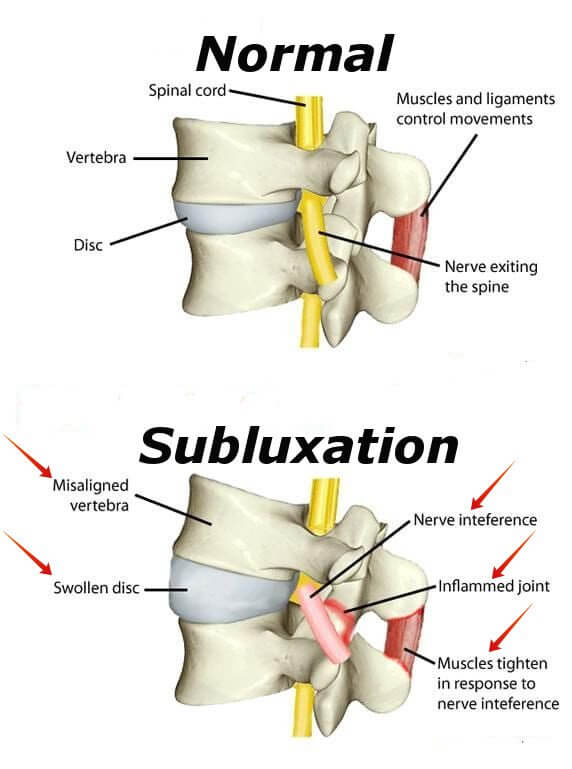Trigeminal Neuralgia Treatment in New York City
The Trigeminal Nerve
What is Trigeminal Neuralgia?
Trigeminal Neuralgia Symptoms
What Causes Trigeminal Neuralgia
Chiropractic Treatment for Trigeminal Neuralgia
Craniosacral Therapy for Trigeminal Neuralgia
Trigeminal Neuralgia Treatment
Trigeminal neuralgia, or mild to severe facial pain, is one of the many conditions effectively treated with a combination of chiropractic care and craniosacral therapy. Episodes of trigeminal neuralgia usually:
- strike suddenly
- Span up to a couple of hours
- are composed of individual shooting electric shock-like pains lasting a few seconds
- appear intermittently, coming and going for days, sometimes weeks. and in some cases even months at a time

While the pain can also disappear for a period of time, sooner or later it typically returns and as it progresses the electric shock-like disturbances on the face last longer and become more piercing. The good news is a combination of gentle chiropractic care and craniosacral therapy can effectively treat both the painful symptoms and underlying causes of trigeminal neuralgia.
The trigeminal nerve is the fifth and largest cranial nerve in the head responsible for sending electrical signals and sensation to and between the brain and face. After leaving the brain, the trigeminal nerve travels within the skull ultimately dividing into 3 branches controlling sensations in zones throughout the face:

- Ophthalmic Nerve: controlling a person’s forehead, eye, & upper eyelid.
- Maxillary Nerve: controlling the cheek, nostril, upper lip, upper gum & lower eyelid.
- Mandibular Nerve: Controlling the jaw and some muscles involved with chewing, lower lip and lower gum.
Nerves in the brain and spinal cord (including the trigeminal nerve) are coated with an insulating protective layer or sheath called myelin.

Any:
- compromising of the myelin layer or
- compressing of the myelin layer or trigeminal nerve itself in some way
can cause over-activity of the nerve resulting in pain. Thus the slightest lesion on the myelin layer or nerve, misalignment or subluxation of the upper cervical spine, bones in the jaw, or past compression whiplash (car accident) can result in trigeminal neuralgia.
Trigeminal neuralgia is a chronic disorder affecting the trigeminal nerve and producing pain in the jaw and face. The pain can be extreme, intermittent, shock-like or sudden burning, constant or surface only during specific activities like speaking or chewing, lasting anywhere from several seconds to a few minutes per attack. These episodes can occur close together, in stretches extending up to two hours. The pain can be surfaced from contact with the cheek (such as when shaving, applying makeup, or washing your face), drinking, or brushing teeth. The pain may be isolated to a small area of your face or it may spread.
Many have reported that their pain emerged spontaneously and seemingly out of nowhere. Others have said their pain appeared after a physical trauma to the face, after a car accident, and after dental work. Since the pain routinely at first surfaces along the upper or lower jaw, people assume they have a dental abscess.
Typically, trigeminal neuralgia surfaces with a numb or tingling sensation in the face, followed by mild, infrequent pinpricks across the face. It can also feel like someone is pressing or touching your chin, lip or cheek. However as trigeminal neuralgia progresses, the bouts of tingling and pinpricks transform into bursts of shooting pain lasting a few seconds to a few minutes, increasing until the pain becomes constant. After the initial incident flare-ups might strike for weeks or months, only to subside and not surface again for years. While the trigeminal neuralgia pain may seem to have disappeared, it often returns with greater intensity, making it important to structure a treatment plan sooner rather than later.
Summary of trigeminal neuralgia symptoms:
- Attacks of severe, jabbing, or shooting pain that may seem like an electric shock
- Spontaneous episodes of pain triggered by touching the face, speaking, chewing, or brushing teeth
- Episodes of facial pain lasting from a seconds to minutes
- Facial pain accompanying facial spasms
- Pain along the trigeminal nerve tract, including the jaw, cheek, gums, teeth, lips, or occasionally around the eye and forehead
- Pain striking one side of the face at a time
- Focused facial pain that spreads in a wider pattern
What Causes Trigeminal Neuralgia
There are several potential causes of trigeminal neuralgia and what they all have in common is the disruption of the trigeminal nerve’s function. Commonly, contact between a normal blood vessel such as an artery or a vein and the trigeminal nerve results in pressure being applied to the trigeminal nerve causing it to malfunction. Any disorder that damages the myelin sheath such as a lesion or multiple sclerosis or a tumor compressing the trigeminal nerve can give rise to trigeminal neuralgia. It’s important to also be mindful that compression of adjacent structures within the brain or trigeminal nerve can lead to trigeminal neuralgia, such as a blood vessel compressing and aggravating the trigeminal nerve in the head. It’s also possible there might be a genetic link playing a role, as trigeminal neuralgia can run in families.
From a chiropractic standpoint, Trigeminal neuralgia is a disorder centered at the 5th cranial nerve, with the problem region identified at the point where the C1 vertebra and the brainstem meet the trigeminal nerve, and to the C2 vertebra. Anyone who’s experienced injuries to the neck or head, upper cervical spine damage can cause a spinal misalignment triggering trigeminal neuralgia. Or a change in posture as we age.

This becomes probable if the spinal misalignment occurs in the C1 – C2 vertebra region, which would apply pressure on the trigeminal nerve. It’s the proximity of the upper cervical spine to the brainstem and trigeminal nerve that makes the region highly vulnerable to compression from the slightest spinal misalignment or trauma.
Case Study: Relieving facial pain with chiropractic treatment not only alleviates trigeminal neuralgia, but it can also relieve low back pain & Bell’s palsy.
Chiropractic Treatment for Trigeminal Neuralgia in New York City
The trigeminal nerve travels off the base of the skull on route to supply nerve stimulation to the face. Any damage or trauma to the upper cervical spine can disrupt the proper functioning of the trigeminal nerve and result in severe facial pain. Conventional medicine typically ignores the underlying cause and treats the pain symptoms with drugs that come with numerous side effects and waning effectiveness over time. However upper cervical chiropractic care relieves trigeminal neuralgia pain naturally, holistically, and permanently. Chiropractic treatment for trigeminal neuralgia centers examining, identifying, and correcting any misalignments or subluxations in the upper cervical spine, particularly in the C1 and C2 bones, and managing symptoms using decompression techniques.
In chiropractic care a subluxation is a mechanical disturbance and misalignment of the spinal column or cranial (bones of the head and face), not necessarily visible on X-rays, that disrupts the functioning of your nervous system, specific joints, tissue, muscle, bony structures, fascia, possibly tendons, ligaments and other parts of the anatomy. It’s important to be aware subluxations and misalignments can be painless, arise for a great many reasons, and can manifest at any point in the course of your lifetime.

Subluxations and misalignments can impose pressure, pinch, and even essentially ‘strangle’ nerves exiting the spinal cord and cranial nerves coming out of the cranium. Once identified I deliver a gentle and precise approach to treatment, meaning you won’t need to worry about any painful popping, twisting, or pulling on your neck and across your back. Correction restores the neck and spine to its normal position so that any interference can be removed and recovery from Trigeminal Neuralgia can begin.
Supplementing correction of misalignments and subluxations may include myofascial trigger point therapy to help reduce inflammation and relieve pain in the area where the nerve is affected. Myofascial trigger points are tight regions in muscles typically caused by inflammation, trauma, and nerve issues of the muscle and can emit pain over the affected region as well as transfer pain to other parts of the body, called referral pain.
In sum, upper cervical chiropractic adjustment alleviates pressure on the trigeminal nerve bundle by easing the neck bones to align with the body’s central axis. Addressing the neck bone misalignments through chiropractic adjustments also ensures that your brainstem and nervous system can communicate well with the rest of your body.
Craniosacral Therapy for Trigeminal Neuralgia in New York City
CranioSacral Therapy has been clinically indicated as effective for treating Trigeminal neuralgia because the methods are believed to be able to achieve fluid motion as well as relief of meningeal (protective membrane layers of the brain and spinal cord) and osseous restrictions (bone lesions and other bone abnormalities) near and around to the facial nerve” – Upledger JE. Craniosacral therapy Part I: Its origins and development.
Craniosacral Therapy is a gentle hands-on approach using the delicate touch of a finger(s) to skillfully balance the cerebrospinal fluid circulating around the brain and spinal cord. Craniosacral therapy differs from chiropractic care notably in that there are no sharp forces or tense acts, and this allows the body to relax and release naturally.
Craniosacral therapy involves applying light pressure of a finger or both hands together to influence the membrane layers of the head and spine containing the cerebrospinal fluid to improve circulation throughout the body. The membrane layer (the Dura Mater) plays an important role in cranial bone movement. The bones in the skull are mobile, there is movement between the plates of the head bones and facial bones. This movement facilitates fluid flow and movement of your bony structures in an area of your head and sacrum (the second to last bone of the spine). This mechanism bring fluid life and healing.
As a Chiropractor and Craniosacral Therapist, I can assess your head, sacrum and cervical spine for anything interfering with the proper functioning of your trigeminal nerve and if so, correct the issue allowing it to heal and return to its full and best health. Craniosacral therapy directly treats trigeminal nerve compression, or entrapment, and anything disrupting trigeminal nerve conduction that causes facial pain.
The trigeminal nerve originates in the pons (part of the brain and spinal cord) and connects with the upper 2 cervical spinal nerve roots in the trigeminocervical nucleus—in the upper spinal cord—and then travels all the way down to the C3 level. The trigeminal nerve can be encroached at any exit point causing trigeminal neuralgia.
Whether due to poor posture, misalignment of joints, herniated discs, an abrupt movement, muscle tension, or even emotional stress. The trigeminal nerve can be pinched typically at the base of the head where the brain meets the spinal cord. Afterward what generally happens is the pinched trigeminal nerve becomes entrapped in the connective tissue (fascia, ligaments, tendons, meninges) which has become less functional. By applying craniosacral therapy I can release any distortions or restrictions in the fluid flow within the tissue which will usually relieve trigeminal neuralgia pain.
Do you have questions about how craniosacral therapy and or chiropractic care can effectively treat trigeminal neuralgia? It’s important to be mindful that everyone’s circumstances are unique and I would have to know a few more details about what you’re coping with to be more insightful of treatment approaches going forward. However if you’re noticing any of the signs or symptoms of trigeminal neuralgia call me for a more personalized and comprehensive conversation.
Alex was born in March 1972. At the age of 7 he started to experience frequent headaches with all the conventional symptoms of a Migraine headache. His particular headache resulted in him experiencing auras, nausea and sensitivity to light with no particular trigger to the onset of the migraine.
After years of treatments, therapies and medications, his headaches were no better and Alex continued to experience them all throughout childhood and into young adulthood. Some years the headaches would come monthly, some years every two to three months and some years weekly. His headaches were incurable, there was nothing that could alleviate the symptoms and head pain. Until he experienced cranial manual therapy, which resulted in the complete eradication of his life-long Migraine Headaches.
At the age of 16 Alex noticed a mild deformity in the right side of his ribs, a slightly lower right shoulder and the experience of constant lower back pain. Although mild, a diagnosis of Idiopathic Adolescent Scoliosis had been labeled.
At the age of 18 he was involved in a serious car accident that exacerbated his lower back pain. Throughout the years Alex had tried a multitude of conventional treatments but continued to suffer on and off with lower back pain, even throughout Chiropractic school and beyond.
In 2015 and fifteen+ years out of Chiropractic school, Dr. Kaminsky participated in his first and life changing Craniosacral Therapy seminar and he was fascinated, intrigued and hooked. It all made sense, he was immediately astute to its methods and since that first seminar, and as a result of trading sessions of Craniosacral Therapy with his colleagues, his back pain subsided and till this day has never returned.
Dr. Kaminsky decided to enhance his skill-set to better serve his patients. He began reaching out to other craniosacral therapists, cranial osteopaths, and many types of leading practitioners from various fields for advise and consultations He also enrolled in Upledger continuing education seminars with a focus on mostly hands-on manual and alternative therapies.
And, as he gained knowledge with his own health issues, he has learned to help more and more patients achieve great health results.
Dr. Alex Kaminsky is headache free and low back pain free, and has committed himself to a life of learning, teaching and treating patients. His emphasis is on the patient’s stored patterns of the body and each individual healthcare needs.
